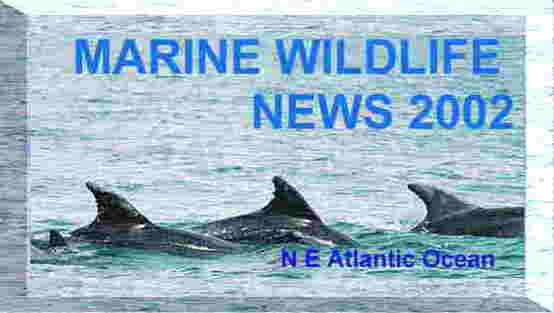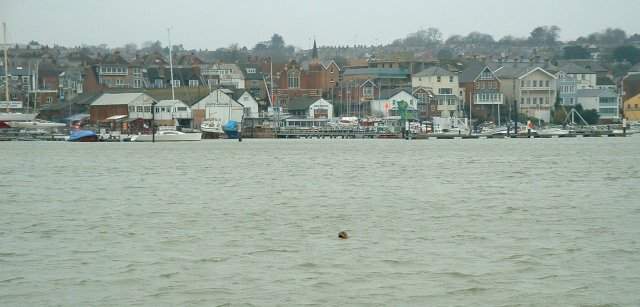1
February 2002
Gales
batter the coasts of Britain, coinciding with exceptionally high tides,
resulting in localised flooding, with the strongest winds across lowland
Scotland.
January
2002
At
least 50 small cetaceans,
mostly dolphins, have been washed dead up on English Channel coasts during
this month. Dolphins are washed up dead every year, but there seems to
be at least double the normal numbers this year. Although, the cause of
death is not known for sure, most people seem to think that fishing activities
are to blame. The cause of the increase is less clear; it could be because
of the bad weather has washed more ashore, it could be because more are
being caught because of increased dolphin numbers, or increased fishing
effort, or it could be because more people are reporting their grisly discoveries.
More
information can be found on the following efora:
Marine
Mammals of the English Channel Smart Group
UK
Cetnet
Cornish
Wildlife Mailing List

New
born
Bottle-nosed Dolphin
with adult, 19 May 2001,
swimming against flood tide, and shallow water
Photograph
by Nicolas Jouault, Jersey
BBC
News Report
Report
Numbers for Stranded Cetaceans
BMLSS
Cetacean Page
Sea
Watch Foundation
Cornish
Marine Wildlife Reports 2001 (by Ray Dennis)
Whale
& Dolphin Society Report & References
26
January 2002
Along
the stretch of coast from west end of Whitsand Bay (Seaton) to Par, and
especially Hannafore Point and Looe
Harbour beach very many small cuttlebones as you describe over last week,
mostly Common Cuttles, Sepia officinalis,
but also smaller numbers of Elegant, Sepia
elegans, and Obigny's, Sepia
orbignyana. The unusually large number
of adult Common Cuttles (100-180 mm) too, sometimes numbered several hundred.
The situation is difficult to monitor accurately as the stormy weather
tends to deposit the cuttlebones, then remove them at the next high tide
and (presumably) drop them again elsewhere. These large concentrations
I have noted before in previous years after prolonged periods of strong
south-west winds, so would suggest that it is likely that weather conditions
are causing the unusually high number of strandings of these floating objects.
We are
getting very large numbers of cuttlebones about 40-60 mm long stranded
along the shores of Whitsand Bay (East Cornwall next to Plymouth Sound)
and in Plymouth Sound. Are there similar strandings elsewhere at the moment?
BMLSS
Cuttlefish Page
19
January 2002
A Cuckoo
Ray, Raja naevus, was discovered in a rock
pool in Cove Harbour , Berwickshire, SE Scotland, by Ben
Tindall, Harbourmaster. It was an adult full
grown specimen at 60 cm. The shallow water species of ray is rarely recorded
in pools, although the Thornback Ray, Raja clavata, has been recorded
in very shallow water in February in the English Channel. The Cuckoo Ray
has not been extensively studied. It is a southern species found
all around Britain and in the Mediterranean Sea and it lays its egg cases
all through the year with possibly a peak in January. This ray could have
found its way into the rock pool as a result of fishing activities. This
ray is common off this North Sea coast and has been recorded in harbours
before.
BMLSS
Sharks and Rays page
 11
January 2002 11
January 2002
Dogwhelks
lay eggs after a 25 year absence
Kingston
Beach, Shoreham Harbour, Sussex.
A
notable discovery were large Dogwhelks,
Nucella
lapillus, averaging 50 mm in length (all a dirty white colour) and
one group were laying their egg capsules. This was unknown on this shore
since the TBT pollution wiped out
the breeding population in the 1970s. A chemical component called tributyltin
in anti-fouling paints caused female Dogwhelks to develop a condition called
imposex which prevented them from breeding.
Full
Report
Dogwhelk
page
Trouble
with Dogwhelks
6 January
2002
Donny
Nicolson reported a decomposed Leatherback
Turtle, Dermochelys coriacea, washed ashore on the Dale beach
at Walls (west Mainland) in the Shetland Isles.
Full
Report on the BMLSS Turtle Page
3 January
2002
A
2.88 metres long female Pygmy Sperm Whale,
Kogia
breviceps, was washed up dead on Thurleston Beach in Devon. This is
an extremely unusual stranding of a deep sea whale. Scientists from the
Natural History Museum in London have taken DNA samples in an attempt to
discover from which population this whale came from. The cause of death
was unknown. This species is much commoner in the southern hemisphere.
The presence of a population west of the Bay of Biscay is possible. This
whale is classified as a Vagrant in the British
Cetacean List.
Further
DetailsBMLSS Cetacean Page
3 January
2002
A
deep water trawler after Blue Ling and Hake etc. caught a female
Giant Squid, Architeuthis dux, amongst the large haul of fish.
With a mantle length of 127 cm it is a medium-sized specimen with some
of the tentacles missing. Therefore, the total length could not be measured,
but it is estimated to be about 5.5 metres with a weight of about 60 kg.
the specimen will be prepared for display at the National
Marine Aquarium, Plymouth, ‘Creatures of the Deep' zone from
May
2002.
This
is believed to be the 25th Architeuthis recorded in British waters
since 1673. Fifteen have been stranded on the shores of the British
Isles, nine caught in fishing gear and one found in the stomach of a Sperm
Whale.
Giant
Squid: Full Report
Aberdeen
University Giant Squid site (by Dr Martin Collins)
There
have been nineteen species of Architeuthis described but
it is unlikely that there are more than seven, and most recent work suggests
that there are three species - Architeuthis dux in the north Atlantic,
Architeuthis
martensi or japonica in the northern Pacific and Architeuthis
sanctipauli in the Southern Ocean. However DNA studies have so
far been carried out on only two specimens, one from New Zealand and one
from Newfoundland (Atlantic coast of Canada), and the results so far published
show no significant differences between them.
According to the Guinness
Book of Records 1991, the largest squid found in British seas was an Architeuthis
monachus found at the head of Whalefirth Voe, Shetland Isles on
2 October 1959. Its total length was measured at 7.31 metres (24 ft).
However, details of this
record may be called into question as it is included in the List
of British & Irish Strandings in year 1949 with a mantle length
of 1.2 metres.
On this list the largest
measured specimen had a mantle length of 1.75 metres and was stranded in
Cove Bay, Aberdeen on 8 January 1984. (My estimate of the total length
would be nearer 6.7 metres or 22 ft.)
The world's largest species
is Architeuthis dux.
EuroSquid
BMLSS
Octopuses and Squids Page
1 January
2002
More
Triggerfish,
Balistes
capriscus, are washed up dead on Cornish shores. The Hocking
family (Sue, Richard, Emma and Rebecca) found
eight Triggerfish on Porthtowan beach, Cornwall.
Reports
from Stella Turk (Link)
Previous
Report

21
December 2001
A
Slipper
Lobster, Scyllarus arctus, was caught in a lobster pot at a
depth of about 60
metres
about 3 miles south east of St Mary’s, Isles of Scilly , just before Christmas
by Barry Bennett.
Realising that it was an unusual and interesting find Barry put it in a
display tank, which he maintains in the Harbour Master’s Office in St Mary’s.
Scyllarus
arctus is a warm waters species found in the Mediterranean, and in
the Eastern Atlantic from Morocco to the English Channel but is rare north
of the Bay of Biscay. They live on stony ground, in caves, and can
also be found on muddy bottoms or in seagrass beds. They use the
large spade-like scales at the front of the head to burrow into mud,
sand
or gravel between and under stones. Only 15 have been confirmed from British
seas all from off Cornwall, the Isles of Scilly or off Plymouth.
Full
Report
Full
Report (CD-ROM only)
via the
Marine
Wildlife of the North-east Atlantic Ocean GroupBMLSS
Crustacea Page |













